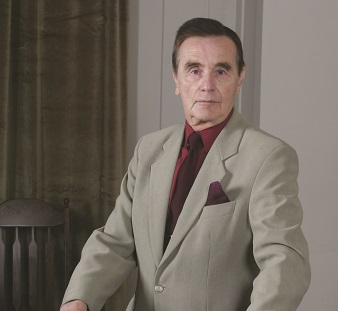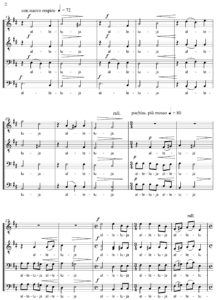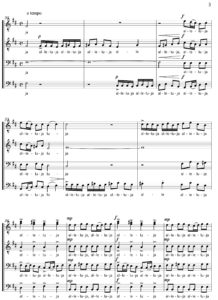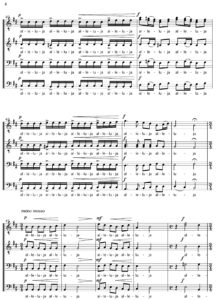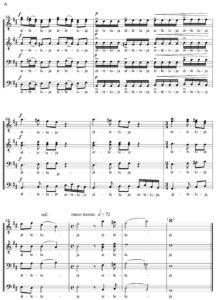When the new and the old become original
Andrea Angelini, ICB Managing Editor
Andrea Angelini: How would you describe your compositional style?
Romuald Twardowski: The features of my music are a moderately modern but communicative musical language, domination of melodic line, limited ornamental elements, clear instrumentation and perfect correlation of music and text. According to various music encyclopaedias, my music represents a separate style in Polish contemporary music. My musical sensibility was formed by different factors and circumstances: traditional church singing (pre-war Polish Vilnius was famous for that), the sound of the church organ, folk melodies, orthodox church music, and the music of Beethoven, Tchaikovsky, and later on, Bartok, Stravinsky, Ravel and Szymanowski. My soul was always closer to European Mediterranean culture than to the Northern European one. All my experiences blended together, and after many years I think I have created a couple of compositional solutions which distinguish my music.
AA How was it possible to continue composing sacred music during the communist period?
RT In the 1940s and 1950s under Stalin there were major repressions which cost the lives of thousands of patriots. Poland, compared to other communist countries, was in many aspects in a slightly better situation, as most of the agriculture remained in private hands and the Catholic church was active. After 1956, artists received a little more freedom, and composers especially could work almost without limitations. It became possible to found a festival of contemporary music ‘Warsaw Autumn’, which presented the latest trends in international contemporary music. But sacred music was not present at all and there was a lack of interest in this field by composers of the time. No limitations were imposed by the authorities. It was against such a tendency that I composed sacred music, including a setting of Psalm 149 in 1962 and in 1976 my Laudate Dominum. In 1968 the Small Orthodox Liturgy was performed and a little later Penderecki presented his large work inspired also by Orthodox church music – Utrenja. I think the ’60s and ’70s were the best times for Polish music.
AA Do you think that the avant-garde, so popular after the war until the 1980s, is today definitely dead?
RT Well, the, good times for the avant-garde and its apostles have passed away. Today it proposes nothing new as it is busy with eating its own tail. But ‘Warsaw Autumn’ still presents a wide range of music but, like many festivals and competitions, does not cause so much emotion as in the past. The demise of the avant-garde is best seen against a composer like Pierre Boulez. The founder of Domaine Musicale, promoter of pointillism, total serialism and other related techniques is now the eager promoter of romantic composers!
AA How has your own style has changed over the years?
RT Towards the end of 1960s I composed several operas, this genre making me modify my style. I needed greater expression, dramatic effects and strong contrasts. The operas Lord Jim [1973] and Maria Stuart [1980] demanded a different musical language and new compositional techniques. This new style I was to call my expressive style – full of emotions and fierce feelings. Later on my music became calmer and more simple. The Concerto breve, Serenade and the Violin Concerto, as well as several choral compositions are examples of the new simplicity.
AA What are your inspirational sources? What allows you to vent your emotions?
RT Art develops by way of evolution not revolution. In the ’60s, during the reign of terror by the avant-garde, the new was promoted as being superior to the old. I dared to say the new is not always better than than the old, as what is new today will be old tomorrow. I proposed the criterion of the original, distinguished from the new. This allows the composer to use traditional musical elements like the triad, but in a new and original manner. I could realize my vision at last – a synthesis of the new and the old, where the past connected with the present. The result was a style I dubbed neo-archaism, quite close to the music of my teacher Nadia Boulanger. In my Paris period I also travelled to Italy. In some works like Antiphons, Three studies of Giotto, Petrarca Sonnets, and the Florence Impressions, I implemented my ideas and paid tribute to a country that would be the home of my dreams. The land of great artists and great art. The dominating emotion in my music at the time was a sense of delight coupled with joyous surprise, and I hope this is clear to the listener.
AA When you sit at the desk, and put those little dots on paper, are you controlling the pencil, or does it have a melodic life of its own?
RT The avant-garde composer has no time for melody. But in my music it plays an important role. And if the pencil is leading me or I am controlling it depends on the mood I am in or, as one says, my inspiration.
AA You were born in Lithuania, the country of the ancient sutartinės.1 Has your style been affected by this particular style of folk music?
RT During the 1950s I came into contact with Lithuanian folk music, and with a lecturer called Jadwiga Čiurlionis, the sister of the famous Lithuanian composer and painter Konstantinas Čiurlionis. She wrote several major books on the genre, offering quite detailed analysis of the sometimes cacophonic multi-voiced expression that allocates sutartinės a separate place the musical development of Lithuania. This archaic form of group singing – akin to a style found in the Balkans – is the source of the aleatoric technique that I often employ in my instrumental music. I used it, too, in my choral works Hosanna II, Lithuania Variations for brass quintet and Lithuania, the latter an orchestra work composed for the 100th anniversary of the birth of Polish Nobel Prize winner Czesław Miłosz, who was also born in Lithuania. It seems I am the only Polish composer to have used authentic Lithuanian folklore, and even the Lithuanian Rhapsody by Karlowicz was based on Belarusian folklore. Generally speaking, since 19th century many Polish artists have been inspired by the country, Stanisław Moniuszko, who wrote the cantata Milda, or writers like Kraszewski and Mickiewicz. But there always was a big difference between the brisk rhythms of Polish folk melodies and overtly calm and in some ways monotonous folk music of Lithuania.
AA Technology dominates our own age. And young people seem obsessed with technical developments. Do we still need composers who write for choirs?
RT Just because young people are so immersed in things technological does not mean they have lost interest in music, or literature, or even art in general. But without art they are often unable to understand the world. The choral movement is the easiest and the most democratic way of meeting young people’s artistic aspirations. And it offers a great opportunity for social life, travel and meeting new people. As a jury member of many choral festivals in Poland I can safely say that the proportion of young people in choirs has grown surprisingly year by year. Many composers, especially those connected with the so-called avant-garde, did not concern themselves with choral music. But as it becomes increasingly difficult to get performances of instrumental compositions, they have started to turn towards choirs as a form of musical expression.
AA What is still missing from your catalogue? What work you would like very much to compose?
RT A string quartet perhaps, maybe I would write like to compose one.
AA If you were able to meet Palestrina, what would you tell him?
RT My dear Giovanni, how about a bit less counterpoint and a bit more emotion?
AA Tell me in just three words how choral music is best described.
RT A good choir is merely the ‘best vocal orchestra’. My compositional career began with choral music and it will probably end that way. It enables me to present both the Western music tradition and Eastern orthodox music. For a choir to sound well, the music must be the sum of well-written parts!
1 Sutartinės (from the word sutarti – to be in concordance) is a form of polyphonic music performed by female singers in north-east Lithuania. The songs have simple melodies, with two to five pitches, and comprise two distinct parts: a meaningful main text and a refrain that may include nonce words. There are almost forty different styles and ways of performing Sutartinės. Mainly, they can be performed by two singers in parallel seconds; by three singers in strict canon, all performing both phrases of the melody at staggered intervals; or by two groups of singers, the lead singer of each pair singing the main text, while the partner sings the refrain, before the second pair repeats. The poetic texts encompass many themes, including work, calendar rituals, weddings, family, wars, history and moments of daily life. Choreography is uncomplicated and movements are moderate, often austere, such as walking in the form of a circle or star while linking arms and stamping feet. Sutartinės are performed on solemn occasions, as well as festivals, concerts and social gatherings. Their performance promotes the sharing of cultural values and provides a feeling of cultural identity, continuity and self-esteem. Sutartinės are usually sung by women, but men perform instrumental versions on pan-pipes, horns, long wood trumpets, fipple flutes and plucked zithers.
 Romuald Twardowski was born in Vilnius in 1930. During years of occupation he studied the violin, after the war piano and organ. Between 1946-1950 he was an organist in various Vilnius churches. Between 1952-1957 he studied composition in the conservatory of Vilnius. He then moved to Warsaw and continued studies at the Warsaw Academy of Music, between 1957-60 in the class of Bolesław Woytowicz. In 1963 and in 1966 he studied Gregorian chant and medieval polyphony in the class of Nadia Boulanger in Paris. Since 1971 Professor of Composition at the Warsaw Academy of Music. The 1960s and 1970s were a fruitful period, seeing the compositino of the operas: Cyrano de Bergerac (1962), Tragedy or the Story of John and Herod (1965), and Lord Jim (1973), and the ballets Naked Prince (1960), Wizard’s Sculptures (1963). The operas Maria Stuart and History of St. Catherine were completed in the 1980s. The catalogue includes around 200 choral works, and compositions for piano and orchestra. Many works have been performed in the USA, the Trio for violin being very successful. Recipient of many prizes and distinctions, including First Prize ‘Polish Young Composers Competition’, two Grand Prix in Monaco, First Prize ‘Prague Spring’, Second Place ‘UNESCO International Composers’ Tribune in Paris, two awards in Tours for choral works, and an AGEC prize (1994). In 2006 he received the ‘Paderewski Award’ (USA). Jury member of many choir competitions.
Romuald Twardowski was born in Vilnius in 1930. During years of occupation he studied the violin, after the war piano and organ. Between 1946-1950 he was an organist in various Vilnius churches. Between 1952-1957 he studied composition in the conservatory of Vilnius. He then moved to Warsaw and continued studies at the Warsaw Academy of Music, between 1957-60 in the class of Bolesław Woytowicz. In 1963 and in 1966 he studied Gregorian chant and medieval polyphony in the class of Nadia Boulanger in Paris. Since 1971 Professor of Composition at the Warsaw Academy of Music. The 1960s and 1970s were a fruitful period, seeing the compositino of the operas: Cyrano de Bergerac (1962), Tragedy or the Story of John and Herod (1965), and Lord Jim (1973), and the ballets Naked Prince (1960), Wizard’s Sculptures (1963). The operas Maria Stuart and History of St. Catherine were completed in the 1980s. The catalogue includes around 200 choral works, and compositions for piano and orchestra. Many works have been performed in the USA, the Trio for violin being very successful. Recipient of many prizes and distinctions, including First Prize ‘Polish Young Composers Competition’, two Grand Prix in Monaco, First Prize ‘Prague Spring’, Second Place ‘UNESCO International Composers’ Tribune in Paris, two awards in Tours for choral works, and an AGEC prize (1994). In 2006 he received the ‘Paderewski Award’ (USA). Jury member of many choir competitions.
(Click on the images to download the full score)

